A complete list of vintage military watches used by the US military
To watch the video, click here↓
Explanation of the characteristics of vintage US military watches
The US military is known as the strongest military in the world, but what kind of watches did American soldiers wear?
Today, I will be explaining vintage American military watches, focusing on the period from World War II onwards, divided into "Army," "Navy," and "Air Force."
Organization of the U.S. military
First, let me introduce the organizational structure of the US military at that time.
Because the battlefields of World War I were mainly in Europe,
European countries organized their military organizations earlier than other countries, and advanced European nations such as the United Kingdom, Germany, and France understood the importance of aerial warfare and were quick to create organizations called "air forces."
They were Great Britain (1918), Italy (1923), Finland (1928), France (1934), and Germany (1935).
The Soviet Union was the earliest, having been formed in 1917.
So, how did the US military possess its air force? Well, it was an "Air Force within the Army" and an "Air Force within the Navy", and there was no independent organization called the "Air Force". Both the Army and the Navy had air units.
Incidentally, the Empire of Japan at that time also had the same organizational structure.
So when did the United States first have an Air Force? Surprisingly, it was late, on September 18, 1947, when the United States Army Air Forces became the Air Force and became independent from the Army.
Features of US Army Watches
At that time in the United States, there was a law called the Buy American Act, which gave priority to purchasing (procuring) domestically produced watches.
The purpose is to develop the country's watch industry and prevent information about the country from being leaked to other countries.
How many watches did you deliver?
If such information were to leak, the number of troops would become known to a certain extent.
Of course, Swiss brands still place orders and purchases in a certain number of quantities.
So, basically, American military watches are mostly made by American brands, and many of these brands remain in existence.
World War II Watches
In 1940, the United States Army introduced a watch with specification number 55-1B, which became the model for military wristwatches during World War II.
The specifications are
1. The number of stones (rubies) must be at least 7
2. The dial should have luminous hands and luminous markers.
3. The case is made of stainless steel.
(But it was actually made of chrome-plated brass.)
4. Olive drab strap
5. 90-day guarantee
6. The clock has an accuracy of ±30 seconds per day.
7. "Appropriate shock resistance and water resistance"
These were the conditions.
This model, called the B-1, was equipped with a hand-wound movement and was mainly
・Bulova
·engine
Hamilton
Waltham
Manufactured by.
These watches were issued to the Army, Royal Air Force, the Allied Russian Government, the Royal Canadian Air Force, the Navy and the Marines.
The Birth of the A-11, an Evolution of the B-1
As the war progressed, the role of watches grew from simply telling time to having to perform many other functions, such as synchronising troop deployments and operations, and checking artillery firing positions.
So in 1943, the Army published a specification for a navigation hack watch, which they named the "USAAF A-11."
The military specification is MIL-W-3818A.
The hack function is a function that stops the second hand by pulling the crown.
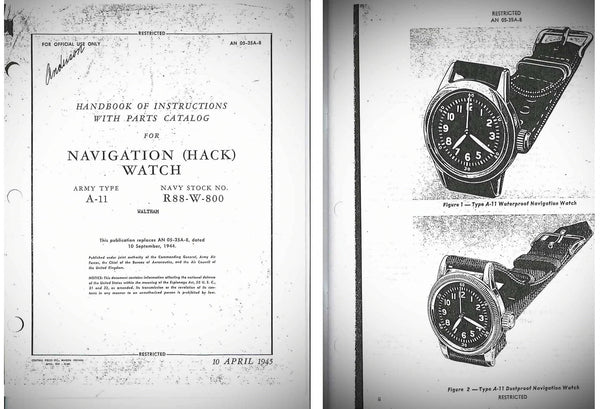

The A-11 was a more complicated model than the B-1, beginning with a 15-jewel movement and requiring specifications that included durability under harsh conditions and the ability to meet certain standards of precision.
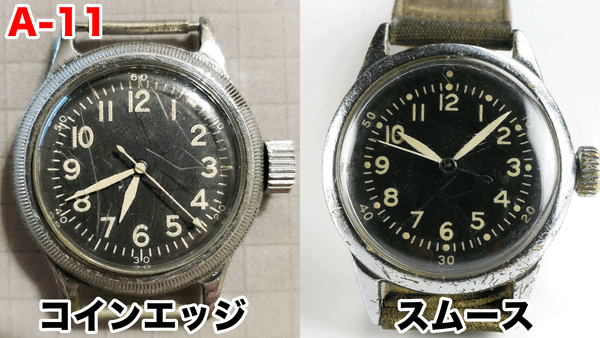
Although the watches look the same, there are two bezel patterns: the coin edge bezel on the left and the smooth bezel on the right.
The standards are also slightly different, with the coin edge bezel being dustproof and the smooth bezel being waterproof.
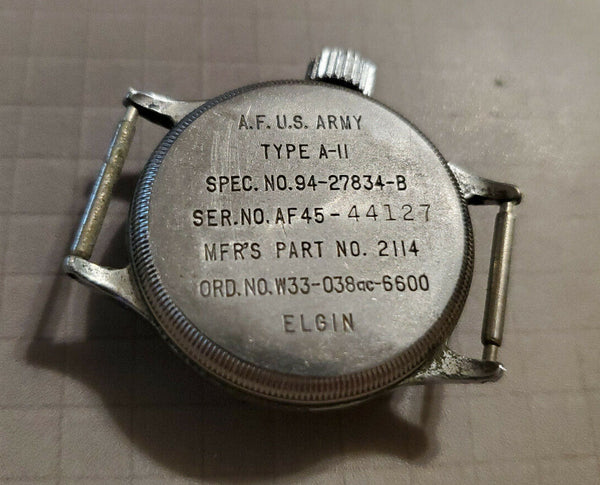
By the way, its Army code was A-11 and its Navy code was R88-w-800.
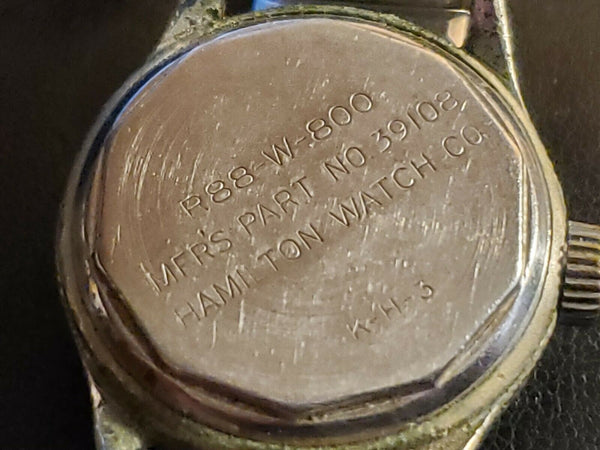
Thus, the A-11 was adopted with more detailed specifications.
The adoption of this model represented the military's recognition that watches were a vital element in modern warfare.
It is available with both a black and white dial and is available in stainless steel with an olive drab or black cotton strap.
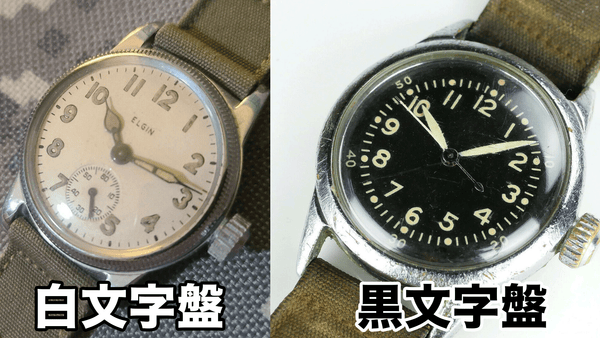
US Navy Special Submarine Service Watches
In 1944, the year after the A-11 specifications were announced, the Navy formed the frogman NCDU (Navy combat destruction unit) to remove mines that had fallen onto the coast during the Normandy landings, and they needed a watch that could withstand the harsh conditions of underwater missions.
As a result, the Navy issued the FSX-797, which added dust and moisture resistance to the specifications and pressure tested it underwater to verify its waterproofness, resulting in the "Navy Bathsips Diver's Watch" with a crown cap attached to the outside of the case by a chain.
Two companies, Hamilton and Elgin, were tasked with manufacturing this Bassip diver's watch.
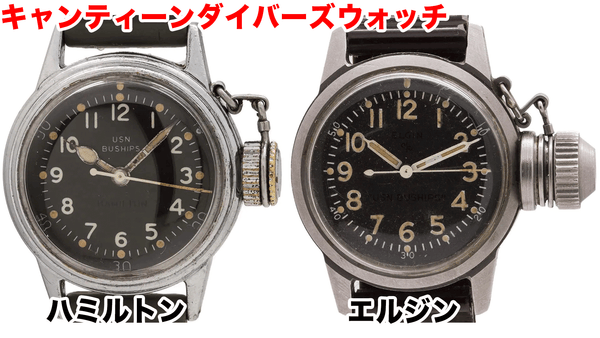
Its distinctive crown cap is reminiscent of a water bottle.
(=Canteen) Also called "Canteen Diver."
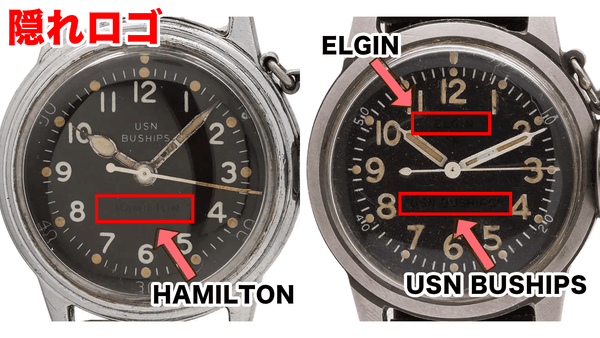
The commonality is,
- Black dial with luminous numbers and hands
・Screw back
・Case size is 32mm
However, if you look closely, you will see that the designs are subtly different.
The crown cap on the Elgin watch is longer, while the Hamilton watch uses a cobra hand.
As for the dial, the Hamilton model has USN BUSHIPS in white letters at the 12 o'clock position, while the Elgin model has it hidden at the 6 o'clock position.
The brand logo is printed in reverse, at the 6 o'clock position on the Hamilton watch and at the 12 o'clock position on the Elgin watch.
Especially with Elgin, at first glance you might wonder what brand it is.
What watch is it?
I have no idea why.
The reason why the letters are printed in black on a black dial is that this model was issued to special forces performing sabotage missions such as reconnaissance in enemy territory, so the letters were made difficult to see and not too much information was printed on them to prevent the affiliation or purpose of use from being revealed.
The back of the case is stamped USN or USN BuShips.

USN stands for United States Navy.
BUSHIPUS stands for Bureau of Shipping of the United States Navy.
It was said to be waterproof to 300 feet, or about 90 meters, when the crown cap was tightly closed.
History of US military adoption of "SEALDs"
The next generation of the canteen diver's watch is Blancpain's Fifty Fathoms TR-900 .
Two deliveries, one in late 1964 and one in mid-1966, totaling approximately 1,000 watches conforming to US military specification MIL-W-22176A, were made by Blancpain through its US subsidiary Tornek-Rayville.
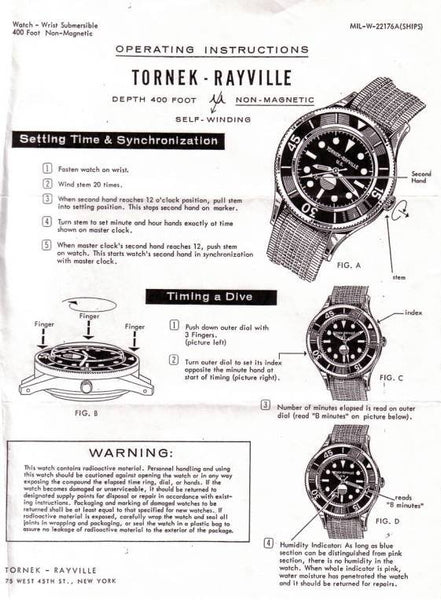
So, the shape is Fifty Fathoms, but if you look at the dial,
It says " Tornek-Rayville."

The movement is also stamped TR-900, indicating that it was issued to the U.S. Navy Special Submarine Forces.
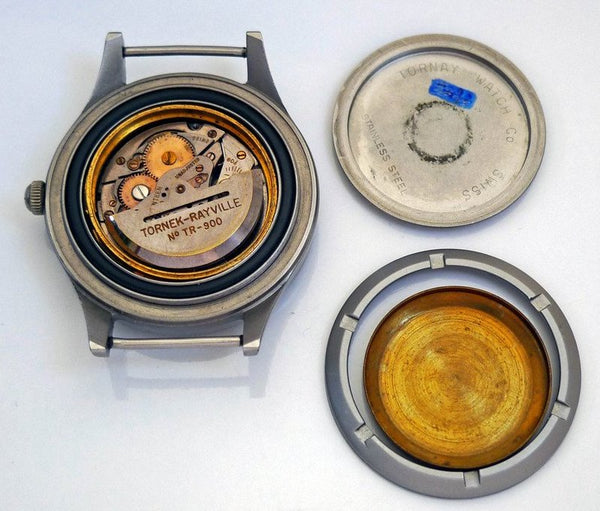
You can think of Tornek-Rayville as something like an American distributor for Blancpain.
The story of Blancpain and Tornek-Rayville is explained in detail here, so please take a look at it when you have time.
The MIL-W-22176A engraving , which indicates that the watch meets the specifications, can be seen on the back cover.
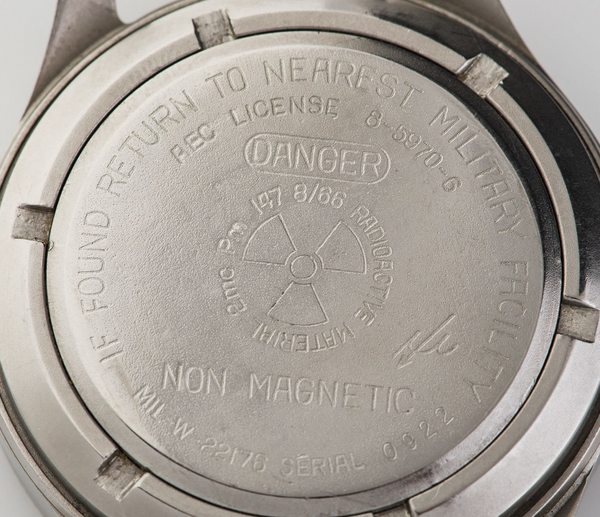
A distinctive feature of Fathoms diver's watches is that they are equipped with a watertightness indication function.
This is to prevent water from getting inside the watch and causing it to malfunction.
Basically, in most countries the watches are kept by the military and given to individuals when they go diving.
Divers must make sure that the watch used by the previous diver is in good condition before diving.
This is because any deviation in the accuracy of a clock can mean a matter of life or death.
When the watch is issued, if half the disc is blue, the diver can wear it with confidence, knowing that it is water-free.
That is why military specifications include a "watertightness indication function."
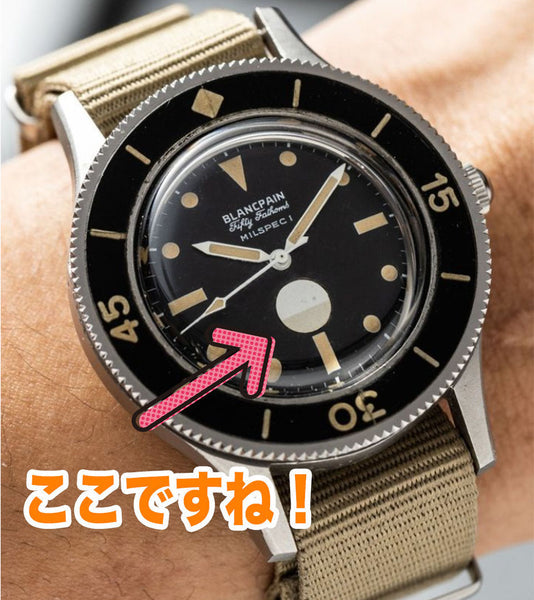
This is indicated by a disc at the 6 o'clock position that changes from white to red.
A new Fifty Fathoms gun was created to meet these standards and took part in military spec testing at the Frankford Arsenal in Philadelphia, USA.
Between 1957 and 1959, various Swiss brands and other international brands participated.
Among them, the only one that passed all the tests was "Fifty Fathoms".
Even in the face of the Buy American law, the Swiss Fathoms watch was chosen, and the fact that it was adopted despite its disadvantages suggests that it had overwhelming power.
There are still many collectors of the Fathoms from that time, but as was common, they were destroyed by the military after their use in the field had ended, so it is said that only a few remain.
Next-generation diver's watch Benrus
In the early 1970s, the U.S. military drew up detailed designs for a diver's watch that met military specifications, MIL-W-50717, and commissioned Benrus to manufacture it.
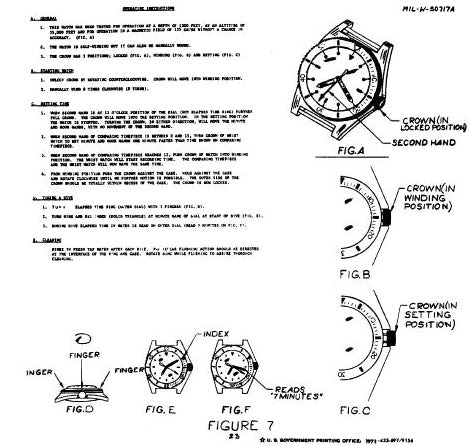
However, in the late 1960s, military budget cuts began to occur, which also affected watches.
The traditional method of making high-quality watches and then repairing them when they break is no longer profitable, so a new idea was born: disposable watches.
What's special about this Benrus watch is that it's highly functional despite being a disposable watch.
These watches were primarily issued to the US Navy Special Forces, but were also issued to the Army Special Forces, Army Rangers, and the CIA Marine Corps.
A one-piece case is used, which gives it a sense of increased robustness and water resistance.
By the way, it is waterproof to 150m.
This watch was produced in two versions.
Type I and Type II.
Now let's take a look at each watch.

The one on the left is TYPE I and the one on the right is TYPE II.
What they have in common is that they both have luminous paint on the indexes and hands, and are equipped with rotating bezels.
And the difference between these types is easy to tell by looking at the dial.
The Type I has a triangular index at the 12 o'clock position, bar indexes at 3, 6, and 9 o'clock, and dot markers at the other hours.
In contrast, the Type II dial uses a traditional 24-hour clock with small triangular indexes for each hour.
The difference between Class A and B is that Type II also has a version called Class B.
Class B watches had no luminous paint on the dials or hands and were used in places like nuclear submarines, where even minute amounts of tritium could cause a reaction.
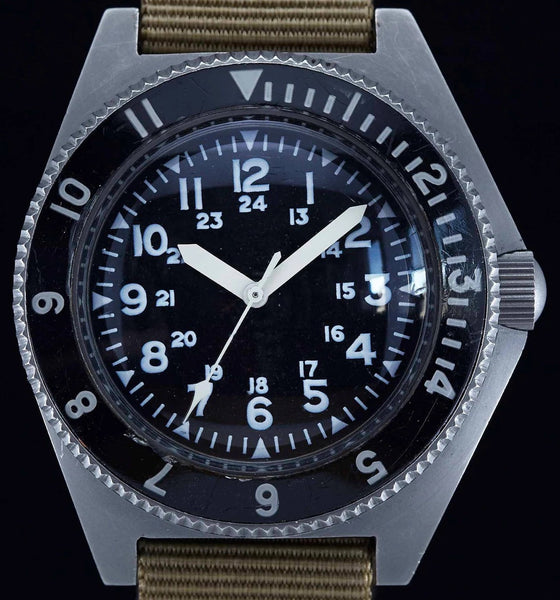
Normally, the triangular marker and the center of the needle would be a faint yellow, but they are pure white.
The white dial, which is the opposite color to the black dial, is used to ensure visibility even inside a nuclear submarine.

On the back of the case
・MIL-SPEC number
·Manufacture name
Product number
·Contract number
·Made date,
·Serial number
is engraved on it.
Benrus manufactured the Type I and Type II for approximately 10 years, from 1972 to 1980.
During that time, approximately 6,000 Type I Class As were produced, just over 9,000 Type II Class As, an unknown number of Type II Class As, and approximately 1,000 Type II Class Bs.
That's why Class B is an extremely rare watch.
Watches adopted by the U.S. Air Force
As mentioned at the beginning, the Air Force became independent from the Army and Navy in 1947, but until then the Air Force also used the A-11.
Then, when the Air Force was formed, a new pilot's watch was created.
From 1950 to 1956 (during the Korean War), the new standard MIL-W-6433 (TYPE A-17) was created and was adopted for watches used by the United States Air Force.
The Type A-17 was manufactured by Waltham.
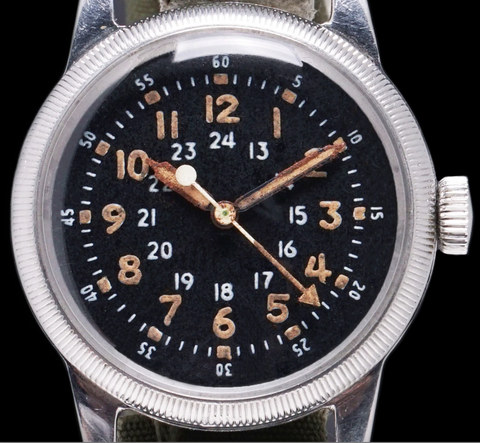
※Waltham TYPE A-17

*Waltham Type A-17 back cover
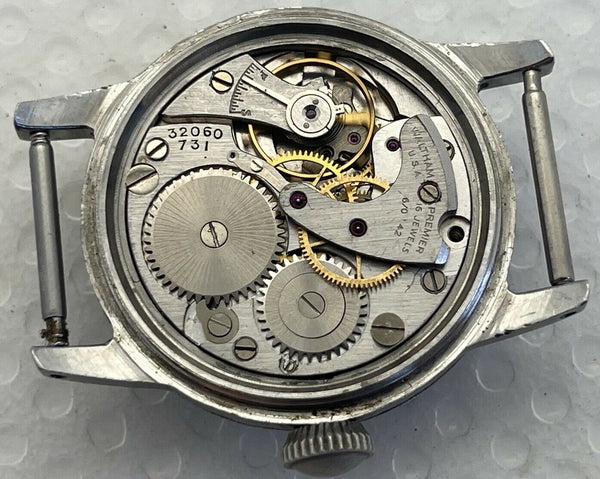
*Waltham TYPE A-17 movement
The type that meets these specifications is the TYPE A-17, which is an evolved version of the A-11 explained earlier.
The A-17 was designed as a navigation watch for pilots and airmen, and its specifications were:
- Radium-painted Arabic numerals and hands
- 5 minute interval index
- Ancillary 24-hour track
was.
The biggest improvement over the A-11 is that the case is now entirely stainless steel instead of chrome-plated brass.
Then, in 1956, an evolved version of the Type A-17 was born; this was MIL-W-6433A (the Type A-17A) and was manufactured by Bulova and Elgin.
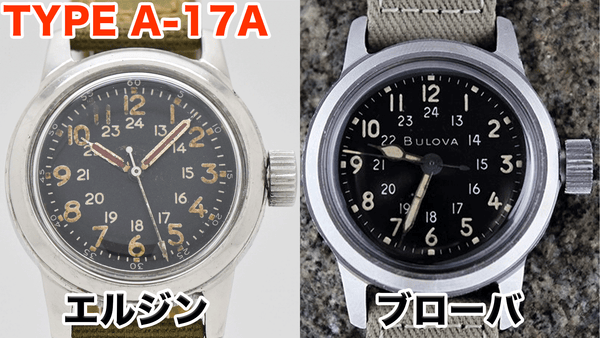
Compared to the TYPE A-17, the only differences are that the coin edge bezel has been changed to a smooth bezel and the snapback has been changed to a screw type.
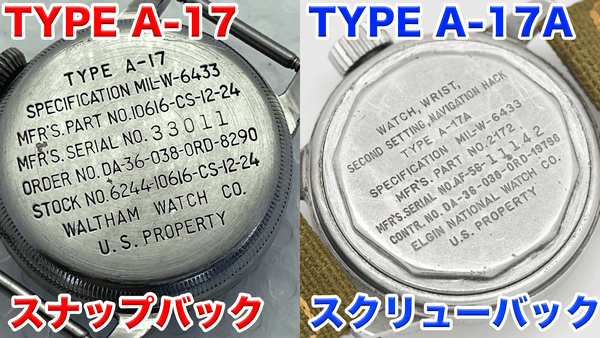
Glycine Airman from the late 1960s to the 1970s

The next watch to be adopted was the Glycine Airman.
The watches up until then were still similar to army watches, but with the change to the Airman, they looked much more like pilot watches.
However, the Airman was not an official military watch.
As a side note, the watches issued to the military are manufactured on a contract basis by the Ministry of Defense, and the costs are included in the government budget.
On the other hand, commercially available watches that comply with military specifications (watches with the same exterior as those worn by soldiers, but with different engravings on the back) may have accompanied soldiers to the battlefield, but have never been procured by the government.
So, to put it simply, the difference is whether the government provides the money or another institution (individual) provides it.
This Airman falls into the latter category.
The Airman was popular among pilots in the Vietnam War, but it was not adopted by the US government.

* Glycine Airman movement Cal.1700/01
Although the functions have suddenly become more modern, it is equipped with many features that pilots prefer, so it is understandable why it was so popular.
It has a slightly unusual structure, but the short hand makes one rotation every 24 hours.
The minute hand continues to function as a minute hand.
I'd like you to pay attention to the hour hand. You will see a short hand sticking out from the end of the hour hand.
This hand allows you to see both 24-hour and 12-hour time at the same time.
So, in this image, the hour hand is at the 20 o'clock direction and the short hand at the bottom is pointing to 8 o'clock, but in 24-hour format it is 20 o'clock, and in 12-hour format it is 8 o'clock.
It also has a rotating bezel with GMT function that allows you to know the time in two countries and has a date display.
summary
I introduced military watches from the US military, the world's strongest military, and my personal impression is that they are cool and have a distinctive American (original) feel, unlike those from continental Europe.
Fathoms was also adopted by the French military, and I think the Benrus Type 1 in particular is a watch that appeals to masculine people, with its simple yet rugged look.
What's interesting is that, as is common with military watches, there are subtle differences that you can't see unless you look closely.



